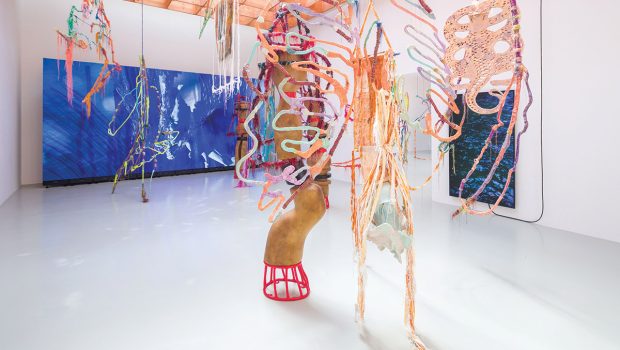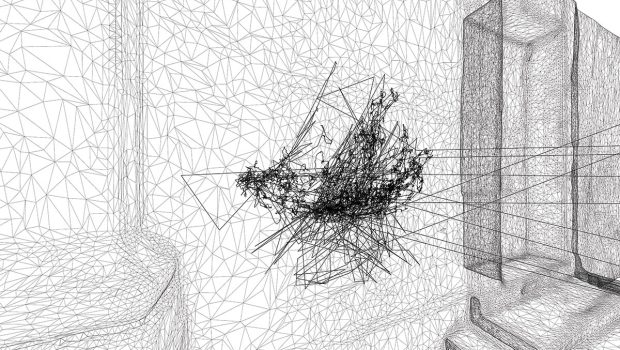Painting, music and other animals…
Art: what’s it all about?
The question is always lurking somewhere in both my conscious and subconscious and I feel that my thoughts and feelings have always been too strong to challenge my intellect for logical reasons, because I feel that sometimes, when it comes to the arts, intellect – or too much of it – can kill spontaneity. Balancing the two out would be the ideal solution, but not everyone has the luxury of time and application to do so.

We could include in this argument all art history going back as far as Lascaux, but let’s try to narrow it down to one specific genre, the Abstract! This is a subject that I can also relate to music which, to me, is always inextricably tied to visual art. Music is intrinsically abstract.
So let me start off here. I had been reviewing music since I was 17. I was not a musician and many at the time considered me to be unqualified for the position – the ‘many’ being the musicians themselves. I always considered myself to be a professional and informed member of the audience and it was primarily for the audience that I wrote.
My aim was, and still is, to remove the veils of obscure jargon of the soi-disant high priests and make music accessible, enjoyable and comprehensible to a much wider spectrum of people, especially those who used to stop me in the street to apologetically inform me that they would have loved to have attended this or that concert but were afraid to as they feared that they wouldn’t understand it! I always retorted: “Do you enjoy listening to music?” and the reply was invariably a “Yes”. “So, therefore,” I continued, “you understand it!”
The same applies to abstract art and a very clear parallel can be drawn here. What is music? An abstract but ordered concatenation of sounds making up a whole would be an interesting way of describing it in a nutshell. What is painting? The deliberate application of line, colour, light and shade on a tabula rasa could be an apt description. What is important is what these descriptions do. What effect to they have on the people who are either listening to, or looking at, them? One would like to think that they create a visual and aural feast of the senses, irrespective of how well-informed or not the audience or viewer is. The wider the appeal, the better the artist.
To return to abstract art, this idea that one must understand ‘art’ stultifies the enjoyment of it. I sometimes think that art critics and cognoscenti are too highfaluting for their own good and there is no greater anecdote than the one of the couple who were trying to make out a large canvas depicting three naked black men sitting on a park bench. The question was that the penis of the man in the middle was pink! Along came the museum curator and, noticing the puzzled couple, explained at great length the question of white and black supremacy, the history of the slave trade and perorations into obscurantism that left the poor couple even more befogged than before. When the bigshot had left, a little man materialised and said: “Do you really want to know what that painting is all about?” “Yes, of course”, replied the couple, a tad worried that they were in for another learned pontification. “Well then,” said the man, “these are three coal miners having a break except the one in the middle went home to lunch!” A trifle silly, you may say, but yes that is most times the fundamental truth of art.
I wonder what Picasso was thinking when he painted Les Demoiselles d’Avignon – apart from them being a collection of beautiful nudes. But the challenge is what Mondrian wanted to convey with his coloured squares and what Rothko wanted us to understand when presenting us with those colossal canvases of colour gradations! Did he want us to understand his suicidal state or did he merely want to create a new way of feasting the senses? I am a firm believer that primarily an artist creates his own idea of beauty and it is a total waste of time trying to analyse it in any other way than the celebrated Sister Wendy method.
It would be the height of presumption to attempt a psychological analysis of an artist’s state of mind from his output. It simply doesn’t tally. Mozart wrote his most genially beautiful work when facing bankruptcy and despair. Can you think of an object of greater revulsion than Grunewald’s Christ on the Cross and yet fail to see its beauty and its pathos? Would this mean that Grunewald was a manic depressive? I do not think so.
I am, therefore, more than ever convinced that there is absolutely no need to ‘understand’ abstract art – or any art at all for that matter – in order to be able to appreciate it and, above all, be moved by it. Here, however, I give a caveat: the enjoyment of a work of art can be intensified by knowing more about it. I have been moved to tears of ecstasy by so many works in my life. Can anyone ever prepare you for the impact of Bernini’s Apollo and Daphne in the Borghese Gallery? Is there not a fundamental reason why crowds stop, speechless, in front of Van Gogh’s Starry Night at the MOMA or in front of the Mona Lisa at the Louvre? One can compare it to the best-loved pieces of music such as Vivaldi’s Four Seasons, Tchaikovsky’s First Piano Concerto or Beethoven’s Fifth Symphony, sometimes ignored by the cognoscenti as hackneyed, obliterated by their own success.
But then why are these greats so great? There must be a very good reason and it’s because they are flawlessly crafted but, above all, they appeal directly to the emotions which is why they could uplift a Hottentot who has never seen or heard anything like them before! Dante says somewhere that “L’Arte al Iddio Nipote” which means that art is God’s grandchild. Never a truer word….
Stand very close to one of Monet’s vast water-lily paintings and you will see the layers of colour flung about a humongous canvas by Jackson Pollock. The beauty of the kaleidoscope that both styles present is mesmerising. So why go through the agonies of trying to fathom some obscure reason as to why Monet and Pollock did this, as long as they can emotionally move you?
What was art after all? Why did the cavemen of Lascaux decorate their walls? Why did the mosaic artists of Ravenna do the same? Why did Michelangelo paint the Sistine Chapel? Apart from the fact that, like everyone else, artists do have to earn a living, it’s man’s basic instinct both to create and to enhance nature with the beauty that comes spontaneously from within the mind and heart of an artist. That is why being intensely moved by a work of art is most of the time inexplicable, but such a wonderful experience. It just does! And that, for me, is more than enough.
So the next time you are standing in front of an abstract, don’t try and fathom what it means but just let it work its magic on you like a great work by Richard Strauss or Messaien!









